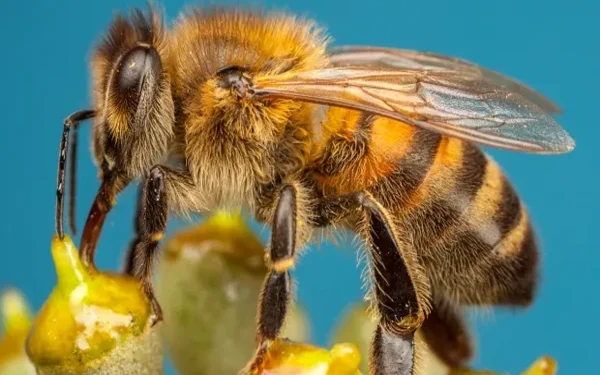Introduction: A Scientific Breakthrough in Neurotechnology and Robotics
In a groundbreaking development that blurs the lines between biology and technology, Chinese scientists have successfully developed a miniature mind-control device designed specifically to control the movements of bees. The innovative technology, created by researchers at the Beijing Institute of Technology, has opened up new horizons in the fields of neuroengineering, bio-robotics, and pollination science. According to the study published in the Chinese Journal of Mechanical Engineering, this micro-device has achieved a remarkable 90% success rate in directing bees’ movements through electrical brain stimulation.
Background: Why Bees?
Bees are among nature’s most efficient navigators and pollinators, capable of traveling vast distances and recognizing complex patterns. Their role in agriculture is invaluable — approximately one-third of the food consumed globally relies on pollination by bees and other insects. However, with the global decline in bee populations due to climate change, pesticide use, and habitat loss, scientists and researchers are turning to innovative methods to preserve their ecological importance and explore how their natural abilities can be leveraged for broader technological applications.
One such method is the integration of cybernetic systems with biological organisms — also known as biorobotics or cyborg insects.
Device Specifications: World’s Lightest Mind-Control System
The mind-control device created by the Chinese team weighs only 74 milligrams, making it the lightest of its kind. To put this into perspective, this is lighter than the natural abdominal cell in a bee where nectar is stored.
Key Features:
- Weight: 74 mg
- Material: Lightweight micro-components compatible with insect physiology
- Design: The device sits snugly on the bee’s back and does not hinder flight
- Control System: Three fine electrodes (needles) penetrate into specific regions of the bee’s brain
The electrodes are designed to interact with the neural circuits responsible for motion and orientation. Using these interfaces, scientists can send electrical impulses directly into the bee’s brain, instructing it to move in a particular direction.
How It Works: Merging Biology and Engineering
The procedure to control the bee’s motion involves three primary stages:
- Attachment of Device: The device is gently affixed to the bee’s thorax. This region is selected due to its robust structure and balance during flight.
- Electrode Penetration: Three ultra-thin electrodes are inserted into precise points within the bee’s brain. These electrodes act as neural interfaces.
- Electrical Impulse Transmission: By sending low-intensity electrical pulses, scientists influence the bee’s decision-making processes — primarily direction and orientation.
In controlled experiments, the researchers were able to guide the bees with 90% accuracy, a significant achievement in neuromechanical engineering.
Applications: Why Control a Bee?
While the idea of controlling a bee may seem niche or experimental, the potential applications of such technology are wide-ranging and transformative.
1. Agricultural Pollination:
With bee populations declining, researchers envision using cyborg bees to artificially pollinate crops. These bees could be directed to specific fields, ensuring targeted and efficient pollination, especially in areas where natural bee populations have been diminished.
2. Surveillance and Reconnaissance:
Given their small size and stealth, bees fitted with micro-cameras or sensors could be used for surveillance in military or security scenarios. Their natural ability to navigate tight spaces would make them ideal for reconnaissance missions in difficult or hazardous environments.
3. Disaster Area Monitoring:
In situations such as collapsed buildings or areas affected by chemical spills, robotically-controlled bees could help rescue teams locate survivors or detect dangerous substances without risking human lives.
4. Scientific Research:
Cyborg bees could be used to better understand insect behavior, communication, and social structures, providing insights into colony dynamics and environmental interactions.
Ethical Concerns and Controversies
While the scientific achievement is undeniably impressive, it has sparked debate in ethical circles. Concerns have been raised regarding:
- Animal Rights: Critics argue that inserting electrodes into a living creature’s brain without consent raises serious ethical questions about the treatment of sentient life.
- Surveillance Misuse: There are fears that such technology could be weaponized or misused by authoritarian regimes for spying or control.
- Ecological Impact: Altering the natural behavior of bees could have unintended consequences on ecosystems, pollination cycles, and biodiversity.
These concerns highlight the need for comprehensive ethical guidelines and regulatory frameworks to govern the use of bio-integrated technologies.
What the Researchers Say
Professor Zhao Ziliang, who led the research team, explained that the project was motivated by a desire to blend biological efficiency with engineering precision. He emphasized that the device was designed to be minimally invasive and aimed at understanding — not harming — insect behavior.
“We are not harming the bee’s functionality or health,” said Professor Zhao. “Our purpose is to explore how biological intelligence can be guided to support human and environmental needs.”
The Study’s Publication and Peer Response
The detailed findings were published in the Chinese Journal of Mechanical Engineering, one of the country’s leading peer-reviewed scientific journals. The study has drawn interest from international academic circles, with many praising the engineering feat while urging further investigation into long-term effects on the bees’ health and ecology.
International experts in bionics and neuroengineering, including teams from Germany, the U.S., and Japan, have called the work “promising” and potentially “revolutionary” but also emphasize the need for rigorous ethical oversight.
Future Prospects: Towards Insect-Cyber Integration
This device is a step forward in the growing field of bio-hybrid systems — machines that work in tandem with living organisms. Future developments could include:
- AI-Guided Bee Swarms: Where hundreds of mind-controlled bees perform synchronized tasks using machine learning algorithms.
- Environmental Sensing Networks: Where bees serve as mobile environmental monitors, gathering real-time data on air quality, humidity, and chemical presence.
- Inter-Species Communication: Long-term visions include enabling rudimentary communication between humans and insect-based bio-robots.
Conclusion: A Pioneering Innovation with Global Implications
The development of a mind-control device for bees marks a significant milestone in the integration of technology and biology. By creating the world’s lightest neuro-interface for an insect, Chinese scientists have opened up unprecedented opportunities in agriculture, surveillance, disaster response, and bio-research.
However, the innovation also demands a parallel conversation about ethics, ecological balance, and the responsible use of emerging technologies. As the world stands at the cusp of a new era in bionics, the lessons from this experiment will likely shape the future of human-insect interaction and beyond.

























